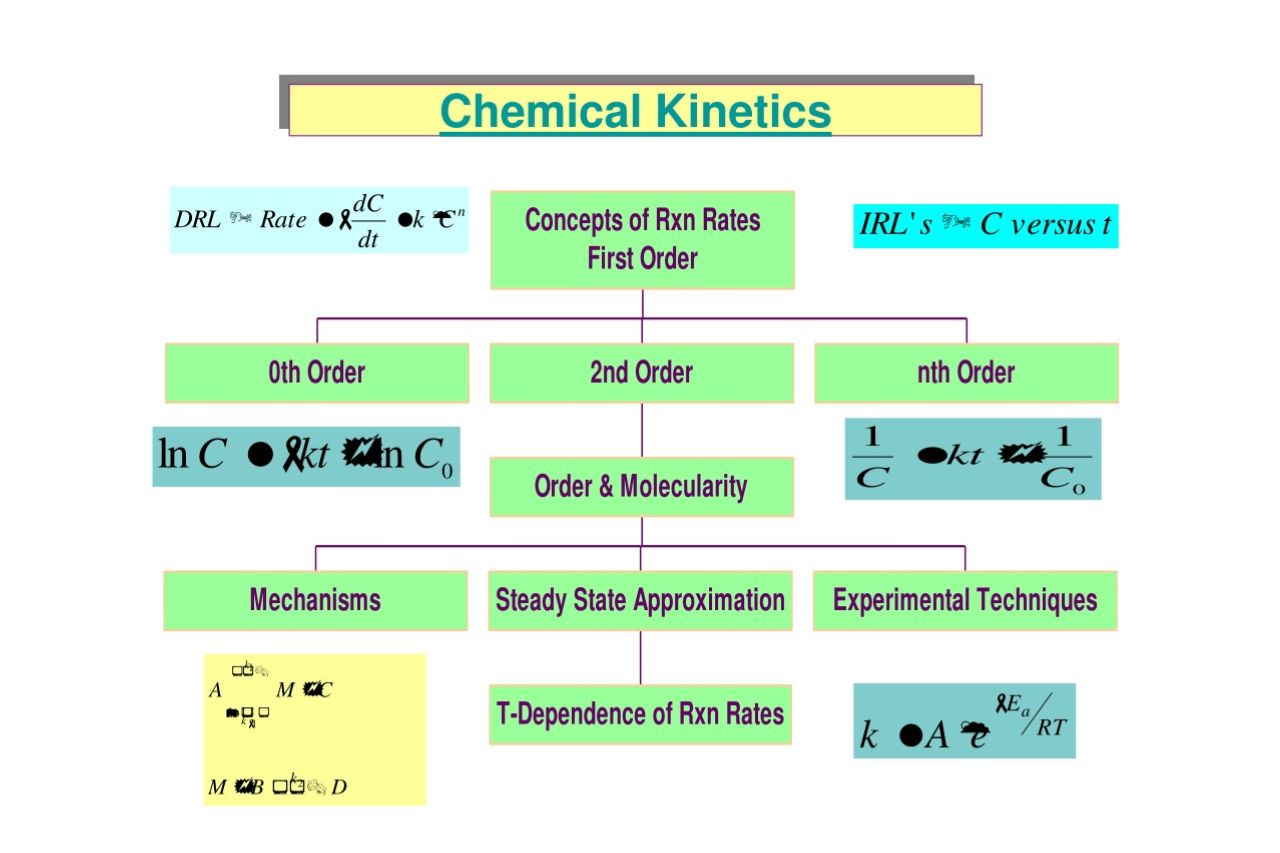
Kinetics, a branch of chemistry that focuses on the study of reaction rates, plays a vital role in understanding the dynamics of chemical reactions. This fascinating field provides insights into how molecules interact and transform over time. From determining the speed of a reaction to discovering the factors that affect reaction rates, kinetics offers a wealth of knowledge that helps scientists and researchers uncover the underlying mechanisms behind chemical processes. In this article, we will delve into the realm of kinetics and explore 16 fascinating facts that showcase the significance and intricacies of this captivating branch of chemistry. So, get ready to dive into the world of reaction rates, activation energy, and catalysis as we unravel the mysteries of kinetics.
Key Takeaways:
- Kinetics is like the speedometer of chemistry, showing how fast reactions happen and what factors affect them. It’s crucial for making medicines, cleaning up the environment, and even understanding explosions!
- By studying kinetics, scientists can figure out how to make reactions go faster or slower, predict how molecules behave, and even design safer energy sources. It’s like being a chemistry detective!
Kinetics is the branch of chemistry that deals with the study of reaction rates and mechanisms.
Kinetics explores how fast or slow chemical reactions occur and investigates the factors that influence the rate of these reactions.
The rate of a chemical reaction can be affected by various factors, including temperature, concentration, catalysts, and surface area.
By manipulating these parameters, scientists can control the rate at which reactions proceed, leading to practical applications in industries such as pharmaceuticals and materials science.
One of the key concepts in kinetics is the reaction rate, which measures how quickly reactants are converted into products.
The reaction rate is determined by the frequency of effective collisions between particles and the energy barrier that needs to be overcome for the reaction to occur.
The study of kinetics has important implications in understanding biological processes, such as enzyme kinetics.
Enzymes are biological catalysts that enhance the rate of chemical reactions in living organisms. Understanding enzyme kinetics helps in designing drugs and discovering new therapeutic targets.
Kinetics is also crucial in understanding the kinetics of drug metabolism by the human body.
By studying how drugs are broken down, scientists can determine the optimal dosage and frequency of drug administration for maximum efficacy and minimal side effects.
Kinetics plays a vital role in environmental chemistry, particularly in studying the degradation of pollutants in air, water, and soil.
By understanding the kinetics of pollutant degradation, scientists can develop effective strategies for remediation and environmental cleanup.
Kinetic studies provide insights into the stability of molecules and their reactivity.
By measuring reaction rates, scientists can predict the shelf life of products, design more efficient chemical processes, and optimize the performance of catalysts.
Kinetic modeling is an essential tool for simulating complex chemical reactions and predicting their outcomes.
Using mathematical equations and computer simulations, scientists can gain a deep understanding of reaction mechanisms and predict the behavior of chemical systems under different conditions.
The field of kinetics has applications in many interdisciplinary areas, including materials science, biochemistry, pharmacology, and environmental science.
By incorporating principles of kinetics, scientists can advance their understanding in these fields and develop innovative solutions to real-world challenges.
Kinetics helps in understanding the explosion and combustion processes.
Studying the rates of chemical reactions involved in explosions and combustion is crucial for ensuring safety and developing efficient energy sources.
The Arrhenius equation is a fundamental equation in kinetics that links reaction rate constants with temperature.
It describes the exponential relationship between temperature and reaction rate, providing insights into the energy barriers that molecules must overcome to react.
Kinetics can be measured experimentally using various techniques, including spectroscopy, chromatography, and calorimetry.
These techniques allow scientists to track the progress of reactions and determine the rate constants and reaction mechanisms.
Kinetics is not only limited to chemical reactions but also applies to physical processes such as diffusion and phase transformations.
Understanding the rates at which molecules move and transform is crucial in fields such as materials science and solid-state physics.
The study of kinetics has historical significance, with pioneers such as A.A. Noyes and Svante Arrhenius making significant contributions to the field in the late 19th and early 20th centuries.
Their work laid the foundation for our current understanding of reaction rates and mechanisms.
Kinetics is both a quantitative and qualitative field, providing insights into the microscopic world of molecules and their behavior.
By combining experimental techniques and theoretical models, scientists can delve deep into the intricate mechanisms that govern chemical reactions.
The study of kinetics is ever-evolving, with ongoing research and discoveries continually expanding our understanding of how reactions occur.
Advancements in technology and computational modeling have opened up new avenues for exploring kinetics and its applications in various scientific disciplines.
Conclusion
In conclusion, kinetics is a captivating field of chemistry that explores the rates of chemical reactions and the factors that affect them. It plays a crucial role in various industries, from pharmaceuticals to agricultural sciences. Understanding kinetics allows scientists to optimize reaction conditions and develop more efficient and sustainable processes.By delving into the key concepts of kinetics such as reaction rates, rate laws, and reaction mechanisms, we gain valuable insights into how reactions occur at the molecular level. Additionally, the study of kinetics provides us with the tools to predict and control reaction outcomes, making it an essential aspect of modern chemistry.Whether you’re a student, a researcher, or simply curious about the world around you, learning about kinetics can open up a new realm of chemical understanding. So, dive in, explore, and embrace the fascinating world of kinetics!
FAQs
1. What is kinetics?
Kinetics is the branch of chemistry that deals with the study of rates and mechanisms of chemical reactions.
2. Why is kinetics important?
Kinetics allows us to understand the speed at which reactions occur and the factors that influence their rates. This knowledge is essential for optimizing reaction conditions and designing more efficient industrial processes.
3. How are reaction rates determined?
Reaction rates are determined by measuring how the concentration of reactants changes over time using experimental techniques such as spectroscopy or chromatography.
4. What are rate laws?
Rate laws express how the rate of a chemical reaction depends on the concentrations of reactants. They help us understand the relationship between reactant concentrations and reaction rates.
5. What are reaction mechanisms?
Reaction mechanisms describe the step-by-step sequence of elementary reactions that occur during a chemical reaction. They provide insights into the pathway by which reactants are transformed into products.
6. Can kinetics predict reaction outcomes?
By studying kinetics, we can predict reaction outcomes and determine the conditions under which certain reactions will proceed. This information is crucial in designing reactions with desired products.
7. How is kinetics used in everyday life?
Kinetics is involved in various everyday processes, such as cooking, digestion, and even the decay of materials. Understanding kinetics helps us optimize these processes and enhance our daily lives.
8. Are there any practical applications of kinetics?
Yes, kinetics has practical applications in fields like pharmaceuticals, environmental sciences, and chemical engineering. It helps in drug development, pollution control, and designing efficient industrial processes.
9. Can kinetics be used in predicting the shelf life of products?
Yes, kinetics plays a role in predicting the shelf life of products by studying the rate at which they degrade or react with other substances.
10. How can one study kinetics?
One can study kinetics through textbooks, online resources, and laboratory experiments. It is also an integral part of many chemistry courses at the high school and university levels.
Kinetics may seem like a complex subject, but our website breaks it down into easily digestible facts. If you're curious about the kinetic molecular theory and how it relates to the behavior of gases, check out our article on the topic. For those interested in enzyme kinetics, our piece on Michaelis-Menten kinetics provides surprising insights. And if you want to explore the kinetic theory of gases further, we have an extraordinary article that delves into its intricacies. Stay tuned for more fascinating chemistry facts!
Was this page helpful?
Our commitment to delivering trustworthy and engaging content is at the heart of what we do. Each fact on our site is contributed by real users like you, bringing a wealth of diverse insights and information. To ensure the highest standards of accuracy and reliability, our dedicated editors meticulously review each submission. This process guarantees that the facts we share are not only fascinating but also credible. Trust in our commitment to quality and authenticity as you explore and learn with us.


